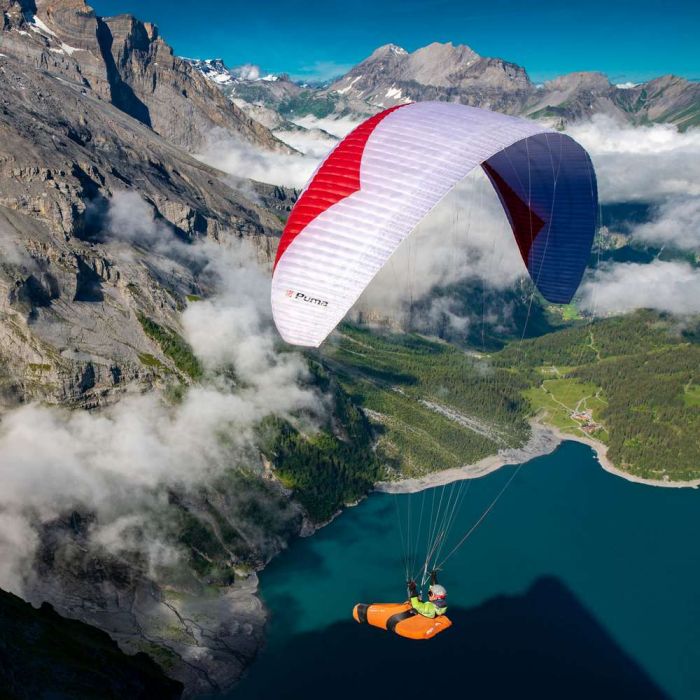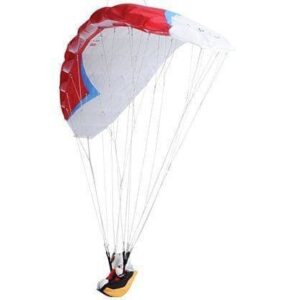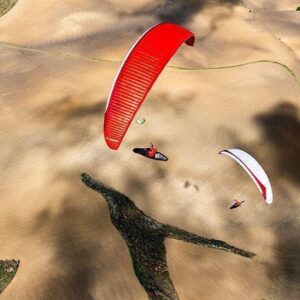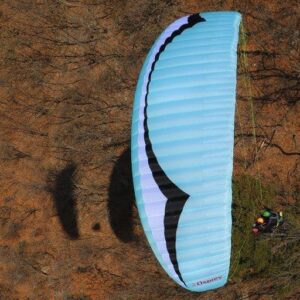Description
Discover the Gin Puma: Unleash Your True Paragliding Potential
The Gin Puma stands as a pinnacle of modern paragliding design. Created with precision and passion, this wing offers pilots an exceptional blend of performance, safety, and comfort. Whether you are an ambitious beginner or an advancing pilot aiming to push your limits, the Gin Puma adapts seamlessly to your flying style.
This paraglider is engineered to deliver a smooth, stable, and responsive flight experience. Its cutting-edge design ensures effortless launches, reliable handling, and impressive glide performance. With the Gin Puma, every flight becomes a unique journey filled with confidence and excitement.
Key Features of the Gin Puma
-
Optimized Performance: The Gin Puma is crafted to provide efficient glide ratios and excellent handling in various conditions.
-
User-Friendly Design: Stability and predictability make this wing perfect for pilots developing their skills.
-
Safety First: Enhanced passive safety features protect you during turbulent air and unexpected situations.
-
Lightweight Construction: Advanced materials reduce overall weight without compromising durability.
-
Comfort and Control: Ergonomic features ensure you remain comfortable and in control on longer flights.
Why Choose the Gin Puma? Performance Meets Reliability
Choosing the right paraglider is critical. The Gin Puma addresses this need by offering an ideal balance between agility and stability. Its aerodynamic profile significantly reduces drag, allowing for smoother thermaling and cross-country flying. Notably, this wing responds intuitively to pilot inputs, making maneuvering both precise and enjoyable.
Additionally, the Gin Puma incorporates innovative technologies developed by Gin Gliders, recognized globally for their superior craftsmanship. These technologies enhance the wing’s structural integrity and flight dynamics, giving you a competitive edge while maintaining pilot confidence.
Designed for Pilots Who Demand More
The Gin Puma suits pilots who want to develop their skills without sacrificing safety or performance. Beginners benefit from its forgiving handling and predictable behavior, while experienced pilots appreciate its advanced flight characteristics and efficiency.
Significantly, the wing’s compact and lightweight profile helps reduce pilot fatigue, enabling longer flights with less effort. This aspect makes the Gin Puma especially appealing for soaring enthusiasts and cross-country adventurers alike.
Highlighted Specifications & Benefits
-
Aspect Ratio: Carefully optimized for balanced performance and safety.
-
Cell Count: Precise cell configuration ensures smooth airflow and consistent wing shape.
-
Certification: Meets top international safety standards, offering peace of mind.
-
Weight Range: Accommodates a wide range of pilot weights for versatile use.
-
Material Quality: Durable fabrics and lines designed for longevity and reliability.
How to Fly the Gin Puma Safely and Efficiently
Flying the Gin Puma is straightforward, thanks to its intuitive handling and stable design. Start with a thorough pre-flight check to ensure all lines and risers are correctly arranged. During takeoff, the wing inflates smoothly with minimal effort, providing an easy and confident launch every time.
Once airborne, the Gin Puma’s responsive steering allows for precise turns and smooth transitions. Always remain mindful of your altitude and airspace regulations to ensure a safe flight environment. Practice active flying techniques to maintain wing pressure and stability, especially in turbulent conditions.
Packing and Care Guide
Proper packing extends the lifespan of your Gin Puma. Fold the wing carefully to avoid creasing the fabric, and store it in a dry, cool place away from direct sunlight. Regularly inspect the canopy and lines for any signs of wear or damage. Keeping your wing clean and well-maintained guarantees consistent performance and safety on every flight.
Final Thoughts: The Gin Puma is Your Ultimate Flying Companion
In summary, the Gin Puma combines innovative design with reliable safety features, creating a paraglider that grows with you. Its blend of performance, ease of use, and durability makes it an outstanding choice for pilots at all levels. Whether you’re soaring your first thermal or tackling ambitious cross-country routes, the Gin Puma delivers a flight experience that inspires confidence and exhilaration.
Elevate your paragliding adventure today—experience the Gin Puma difference.
Ready to take off? Explore the Gin Puma and start your next flight with unmatched performance and safety.
Product Highlights at a Glance:
-
High-performance glide and handling
-
Enhanced passive safety features
-
Lightweight yet durable materials
-
Suitable for beginner to intermediate pilots
-
Certified to rigorous safety standards
-
Comfortable ergonomic design for long flights
Soar Higher and Lighter with the Gin Puma
For elite pilots who crave speed, precision, and efficiency, the Gin Puma is the answer. As the ultimate hike-and-fly competition glider, it offers race-grade performance in a lightweight design. Whether you’re climbing alpine peaks or chasing XC records, the Puma delivers the power and control to perform at your peak.Gin Vantage 3
Ultra-Light Without Compromising Strength With Gin Puma
Built over 1 kg lighter than the legendary Leopard, the Gin Puma sheds excess weight while maintaining competition-class performance. Crafted with Skytex 27 double-coated fabric and Nitinol rods, this glider provides structural strength without bulk. Because every gram counts when racing, this weight optimization is a game-changer.https://www.instagram.com/paragliding_explorer_wing_shop?igsh=bGg2dWxqNzQ1bzF4&utm_source=qr
Additionally, the reduced weight makes take-offs smoother and landings more manageable—especially in difficult terrain. So, whether you’re pushing limits in the X-Alps or soaring through mountain ridgelines, you’ll feel the benefit on every flight.





Precision Handling for Demanding Pilots
Engineered with Gin’s latest two-liner architecture, the Puma gives pilots exceptional agility and feedback. Transitions between thermals are seamless. Turns feel crisp. Control inputs are direct and reliable. Moreover, you can stay efficient even when conditions shift rapidly.
Although it’s a high-performance wing, the Gin Puma doesn’t feel nervous or twitchy. Instead, it maintains pitch stability and glide efficiency—even on bar. Consequently, it gives pilots confidence in turbulent or tight spaces.
Designed for Competition and XC Mastery
The Gin Puma’s high aspect ratio and 86-cell layout are tuned for maximum glide and climb. It accelerates quickly yet remains steady under pressure. Additionally, rear riser steering allows you to maintain speed while subtly adjusting course.
While the Puma excels in hike-and-fly races, it also thrives in classic cross-country missions. Because of its lightweight build and competition performance, you can pack lighter and fly farther than ever before.
Final Thoughts: Go Light, Fly Fast
Ultimately, the Gin Puma is for pilots who demand more—from themselves and their gear. So, if you’re chasing podiums or personal bests, this glider equips you for the journey. Choose the Gin Puma, and take flight with power, purpose, and precision.
- glide performance at the top of the 2 liner EN D category
- best in class top speed
- light and compact enough for hike ’n fly races: just 3.8Kg for the XS (70-88Kg) and 4.1Kg for the S (85-102kg)
- exceptional sink rate in climbs
- light, direct, agile handling
- easier nil wind take-off
TECHNICAL SPECIFICATIONS
| SIZE | XS | S |
|---|---|---|
| Flat area (m2) | 20.5 | 22.32 |
| Flat span (m) | 12.08 | 12.63 |
| Flat aspect ratio | 7.12 | 7.15 |
| Flat aspect ratio (CIVL) | 6.86 | 6.9 |
| Projected area (m2) | 17.56 | 19.14 |
| Projected span (m) | 9.79 | 10.25 |
| Projected aspect ratio | 5.45 | 5.5 |
| Chord (m) | 2.2 | 2.21 |
| Number of cells | 86 | 86 |
| Glider weight (kg) | 3.83 | 4.13 |
| Weight range (kg) | 70-88 | 85-102 |
| Certification | EN D | EN D |
High performance DNA
As a lightweight adaptation of the proven 2 liner Leopard, the Puma is probably the best-performing EN-D light wing ever. All the high performance DNA of the 86 cell Leopard has been retained. Most notably, the glide performance in headwind does not suffer due to the lighter construction.paraglider fabric
Speed in reserve
The Puma excels not only in glide performance but also in ultimate maximum speed. Due to the high wing tip stability in accelerated flight, the wing is able to reach a very high maximum speed. Even at such high speeds, the glide remains flat and stable.paraglider fabric
Light enough for the toughest hike ’n fly races with Gin PumaThe design goal of the Puma was to reduce the weight of the Leopard whilst sacrificing nothing whatsoever in performance. Thanks to the careful optimisation of internal structure and materials, the Puma is over 1kg lighter than the Leopard. This puts the wing firmly in the category of wings for hike ’n fly races such as the X-Alps and X-Pyr, yet the performance is still good enough for serious XC racing. The experience of our race athletes has been incorporated into the development of the wing.paraglider fabric
Climbing and handling
The handling is light and direct, giving the pilot a coherent picture of the airmass. The high agility means that the wing responds very well to small pieces of lift. The stall point is readily identifiable, and apart from the obvious safety benefit it’s also useful for tricky landings in challenging terrain.paraglider fabric
Take-off
The Puma will get airborne effortlessly in zero wind conditions and even slight tailwinds are possible with appropriate pilot technique. In stronger winds, pilots only need to pull gently on the centre A1 lines to initiate the inflation, the wing will rise evenly overhead almost on its own.paraglider fabric
DESIGNER NOTES Gin Puma
Test pilot Idris Birch explains the development of the Puma.
Pilots were asking us for a lightweight Leopard that could be used in hike ’n fly competitions like the X-Alps and X-Pyr – thus the Puma was born.
Pilots who have flown the Leopard will feel very at home on the Puma. We managed to keep all the performance but the take-off is noticeably lighter.
In the air, the handling is lighter and more direct which makes it possible to eke out a saving climb from the tiniest scraps of lift. It also handles great in strong thermals, besides the Alps and Pyrenees, we battle-tested the Puma in Valle de Bravo.
The Puma is not absolutely the lightest wing in its category as we decided not to compromise the performance. Instead we optimised the weight by the careful analysis of the internal structure and material choices. If you prefer to win hike and fly races from the air, or use one wing for both XC and hike ’n fly, the Puma could be just the wing for you.wing falcon
GIN athlete Standa Mayer gives his impressions of the Puma
“As a veteran of 2 X-Alps editions and 3 X-Pyrs, I’ve been closely involved in the development of the Puma. It’s always useful to have better performance and top speed than the other competitors, and the Puma provides this perfectly.”wing falcon
DETAILS Gin Puma
- Second generation Equalized Pressure Technology (EPT) profile significantly improves the lift to drag ratio (CL/CD) and stability at higher speeds
- 2 line risers with easy B-control
- 86 cells for a cleaner top surface and reduced ballooning
- Optimized mix of 3 and 4-cell blocks
- Cross beams for high stability, optimized to reduce weight
- Unsheathed aramid lines
- Mini-ribs on the trailing edge
- Delivered with light Dyneema risers, regular weight risers available as an optional extra
MATERIALS
Canopy cloth
Upper surface: Porcher Skytex, 27 g/m²
Lower surface: Porcher Skytex, 27 g/m²
Lines
Upper: Dyneema / Aramid 9200-030 | 8000/U-050 8000/U-070 | 090
Middle: Dyneema / Aramid 9200-030 | 8000/U-050 8000/U-070 | 090 | 130
Main: Dyneema / Aramid 8000/U-050 | 130 | 190 | 360
Safety to Fly: Confidence with the Gin Puma
Flying safely is paramount, and the Gin Puma is designed to support pilots in maintaining maximum control and security during every flight. This paraglider incorporates advanced safety features that enhance passive safety, helping you handle unexpected conditions with greater confidence.miniature wing
miniature wing Built-In Safety Features
The Gin Puma excels in offering stability in turbulent air. Its aerodynamic profile and optimized wing shape reduce the chances of sudden collapses. Additionally, the wing recovers quickly and predictably if disturbances occur, allowing you to react calmly and effectively.miniature wing
Moreover, the Gin Puma complies with the latest international certification standards, reflecting its tested performance in diverse flying scenarios. This certification assures you that the wing meets strict safety and handling criteria, providing peace of mind whether you’re training or enjoying more challenging flights.miniature wing
Pilot Responsibility and Best Practices
While the Gin Puma provides a solid safety foundation, pilot awareness and proper technique remain critical. Always perform thorough pre-flight inspections, ensuring all equipment is in good condition and correctly rigged.
Before launching, assess weather conditions carefully. Avoid flying in turbulent or rapidly changing weather that exceeds your experience level. Use the wing within its certified weight range and follow recommended operational guidelines.
During flight, maintain active piloting skills. Keep the wing pressurized by making small, continuous inputs to counteract turbulence. Stay alert to airspace regulations and other aircraft, prioritizing safety for yourself and others.
Emergency Preparedness
In rare cases where an emergency arises, the Gin Puma’s responsive handling helps you execute recovery maneuvers efficiently. Familiarize yourself with emergency procedures, such as rapid descent techniques and reserve parachute deployment. Regular training and practice with certified instructors will improve your reaction times and decision-making skills in critical situations.
Guide to Use: Getting the Most from Your Gin Puma
Flying the Gin Puma is an exciting experience made easier with proper preparation and technique. This guide walks you through the essential steps to safely and confidently use your wing, whether you’re a beginner or progressing pilot.
Pre-Flight Preparation
-
Equipment Check:
Before every flight, thoroughly inspect your Gin Puma canopy, lines, and risers. Look for any tears, line frays, or loose connections. Make sure your harness and helmet are secure and comfortable. -
Weather Assessment:
Evaluate wind conditions, thermals, and cloud cover. Avoid flying in strong turbulence, gusty winds, or rapidly changing weather. The Gin Puma performs best in stable, moderate wind conditions suitable for your skill level. -
Weight Range Compliance:
Confirm your total flying weight (pilot plus gear) fits within the wing’s certified weight range. Staying within these limits ensures optimal handling and safety.
Launching Your Gin Puma
-
Layout: Spread the canopy on the ground with the leading edge facing into the wind.
-
Line Check: Confirm lines are untangled and properly connected to the risers.
-
Inflation: Gently pull the risers to inflate the wing. The Gin Puma inflates smoothly with minimal effort.
-
Takeoff: Once the wing is stable overhead and fully inflated, accelerate forward steadily until lift-off.
In-Flight Handling
-
Control Inputs: Use smooth and deliberate brake inputs to steer. Avoid abrupt movements to maintain wing stability.
-
Active Flying: Keep the wing pressurized by making slight, continuous adjustments. This technique helps prevent collapses in turbulent air.
-
Thermal Soaring: Utilize the Gin Puma’s responsive handling to efficiently circle in thermals for lift, extending your flight time.
-
Speed Management: Use the speedbar (if equipped) to adjust your forward speed, but always stay within recommended limits.
Landing Procedure
-
Approach: Choose a clear landing zone free of obstacles.
-
Final Approach: Maintain a steady descent path while controlling your speed with brake inputs.
-
Flare: Just before touchdown, gently pull the brakes fully to reduce descent speed and land softly on your feet.
-
Post-Landing: Quickly gather your canopy to avoid damage from wind gusts.
Packing Your Gin Puma
Proper packing preserves your wing’s fabric and structure:
-
Clean Surface: Lay the wing on a clean, dry surface.
-
Line Management: Straighten and stack lines carefully to avoid tangling.
-
Folding: Fold the canopy neatly without sharp creases.
-
Storage: Store your Gin Puma in a breathable bag, away from moisture and direct sunlight.
Gin Puma FAQ and Troubleshooting
Frequently Asked Questions
Q: What skill level is the Gin Puma best suited for?
A: The Gin Puma is ideal for beginner to intermediate pilots. Its stable and forgiving design supports skill development while offering enhanced performance.gleitschirmfliegen tandem
Q: What is the certified weight range for the Gin Puma?
A: The wing’s certified weight range varies by size. Always check your specific model’s documentation to ensure your pilot and gear weight fall within the recommended limits for optimal safety and handling.
Q: How often should I inspect my Gin Puma?
A: Conduct a thorough inspection before every flight and a detailed check every few months, depending on usage frequency. Look for wear, line tension, and canopy integrity.
Q: Can the Gin Puma be used in cross-country flying?
A: Yes, the Gin Puma’s efficient glide and handling characteristics make it well-suited for cross-country flights, especially as your skills grow.
Q: How should I care for my Gin Puma during storage?
A: Store your wing in a cool, dry place, away from sunlight and chemicals. Avoid compressing it tightly for long periods to maintain fabric and line longevity.gleitschirmfliegen tandem
Troubleshooting Tips
Issue: Wing doesn’t inflate smoothly during launch.
Solution: Check for line tangles or twists. Ensure the leading edge is properly spread out facing into the wind. Use a steady, controlled pull on the risers to help the wing rise evenly.gleitschirmfliegen tandem
Issue: Wing feels sluggish or unresponsive in flight.
Solution: Confirm you are within the certified weight range. Also, inspect for any damage to lines or canopy that could affect performance. Adjust your brake input technique to be smooth and consistent.
Issue: Unexpected wing collapses in turbulence.
Solution: Practice active flying by making subtle control inputs to maintain wing pressure. Avoid flying in conditions beyond your experience level or where turbulence is severe.
Issue: Brake lines feel tight or uneven.
Solution: Check line length and tension. Adjustments should be made by a professional if necessary to ensure balanced handling.
Additional information
| Size | XS, Small |
|---|
Related products
-

-

Gin Leopard
£3,000.00Select options This product has multiple variants. The options may be chosen on the product pageAdd to WishlistAdd to Wishlist -

Gin Fuse 3 paraglider TANDEM EN B
£3,500.00Select options This product has multiple variants. The options may be chosen on the product pageAdd to WishlistAdd to Wishlist -





Reviews
There are no reviews yet.